For this article I’m going to return to a subject I covered yesterday, that of ‘porn statistics’ or, to be more precise, statistics published widely on both the internet and by newspapers and other media organisation which purport to show that large numbers of children and young people are encountering or accessing pornography via the internet.
To quickly recap where we are with this issue so far, yesterday I showed that a ‘statistic’ cited by the Daily Mail while reporting a survey of parents conducted by the National Association of Head Teachers, which found that 90% wanted some sort of default setting on computers and smartphones that would block access to ‘adult material’, actually originated from pretty much nowhere in 2001 in a self-published book by Mark Kastleman, a self-professed former sex/porn addict who, not uncoincidentally, also turns out to be the co-founder of a Utah-based online ‘sex addictions clinic’.
The ‘statistic’ in question claims that the average age at which a child first sees ‘inappropriate images’ is just eleven years of age, but that claim appears nowhere else in any credible published research nor, indeed, does it appear in the second edition of Kastleman’s own book, which was published in 2007.
I also noted that one of Kastleman’s partners in his ‘online clinic’, which offers to cure your addiction to sex, pornography and/or masturbation from just $49 per month, is Utah-based psychiatrist, Dr Randall F Hyde, whose apparent approach to dealing with homosexuality while working as an intern at the University of Utah was, to say the least, unorthodox and grossly unethical, to whit:
Deeply wounded after the painful break-up of my first Gay relationship in July 1986, I scurried back to the security of Mormonism. I tried re-orientation therapy one last time to make me a heterosexual, through the University of Utah Counseling Center. A Mormon intern there named Randall F. Hyde (now an adjunct professor at BYU and chair of the Psychology Department at Utah Valley Regional Medical Center in Provo) put me through several sessions of extremely debilitating hypnotherapy, which culminated in a session during which Hyde hypnotized me and then had me split myself into “Gay Connell” and “Straight Connell”. He then had me visualize Jesus coming down through the ceiling and utterly destroying Gay Connell to dust and then “a mighty wind” blowing all the dust away. This is the single most emotionally, psychologically, and spiritually crippling experience of my entire life. Some 18 years later I am still healing from that traumatic “therapeutic” experience.
This was, of course, not the only statistic cited, without any kind of attribution or source, by the Daily Mail. In addition to its claim about 11-year-olds, the Mail also claimed that ‘around 80% of teenagers regularly access porn’ and that:
Research has shown that 90 per cent of children aged eight to 16 have viewed porn online, often unintentionally.
That last claim is widely cited on the internet, mostly on conservative anti-porn campaign websites by US companies selling ‘net nanny’ software and in some cases you will find that this ‘statistic’ given the following attribution:
Nine out of 10 children aged between eight and 16 have viewed pornography on the Internet. In most cases, the sex sites were accessed unintentionally when a child, often in the process of doing homework, used a seemingly innocent sounding word to search for information or pictures
(London School of Economics, 2002)
The earliest datable reference to this ‘statistic’ I can find goes all the way back to 25 June 2003, where it appears in the US Congressional Record in a motion promoting ‘National Internet Safety Month’ that put to the United States Senate by a now-former Republican senator from Missouri, James Talent. Talent’s Wikipedia entry notes, amongst other things, that he had a record of people ‘particularly outspoken’ on issues such as “judicial appointments, abortion, flag burning, and defense issues” in addition to serving as a senior advisor on both the McCain and Romney presidential campaigns.
Talent’s 2003 motion to the US Senate states that:
According to the London School of Economics, 9 out of 10 children aged between 8 and 16 have viewed pornography on the Internet. In most cases, sex websites were accessed unintentionally when a child, often in the process of doing homework, used a seemingly innocent sounding word to search for information or images.
And, you’ll notice that Talent does not give a precise source for this claim, nor does he cite a specific piece of research. Nevertheless he does state that this statistic originated from the London School of Economics, one of world’s leading social science research institutions.
However, there’s a problem here. I spent good part of yesterday afternoon to locate the original LSE source for this ‘statistic’ and drew a total blank. I can find nothing on the LSE’s website, nothing in its research archives and nothing in any newspaper or other credible media source to indicate where this claim originated.
So, yesterday evening, I fired an email off to Professor Sonia Livingstone who is currently, amongst other things, the Director of the EU Kids Online project and a member of the Executive Board of the UK’s Council for Child Internet Safety, where she serves as it’s ‘evidence champion’, and asked her if she had any thoughts on where this ‘statistic’ might have originated.
This is Prof. Livingstone’s reply, in full:
Hello there – I have searched for this everywhere in my documents (which go back to the early 1990s) and found nothing. My recollection is that I did a qualitative study in the late nineties which produced higher estimates of access to pornography than any of my larger scale quantitative research has since found. I haven’t ever studied the age group 8-16. So while it could be based on something I once said, it is not an accurate quote and it isn’t relevant to today in any case.
Best, Sonia Livingstone
So there is a remote possibility that this 90% ‘statistic’ might have originated with something Prof. Livingston once said, more than ten years ago, when speaking about her early quantitative research but as she’s never worked specifically with the 8-16 age group even this looks extremely doubtful – and this is from of one of the leading researchers into online safety in the European Union.
So, thus far, it would appear that the claim that 90% of children aged between 8 and 16 have viewed pornography on the Internet is not just a woefully out of date zombie statistic but also a complete fabrication, right to down to its attribution to the London School of Economics.
So if it’s not 90%, then what is the truth here?
Well, I’ve taken a look at Prof. Livingstone own published research and to get a clear picture of what is actually going on with young people and online pornography we need to look at and compare two research studies, which were published around seven years apart.
The first of these is the ‘UK Children Go Online‘ report, which was published in 2004 and which reflects the position that existed at around the time that this false 90% ‘statistic’ entered the public domain. For our purposes, the key data we need is summarised in this graph, which shows us the percentage of children and young people aged from 9-19 who had seen pornography on the internet and how they’d come across it.
So, back in 2004, 57% of the children and young people included in the survey had seen some sort of pornography on the internet, but only 10% had actually viewed it deliberately and in the youngest age group (9-11), where there is inevitably going to be the greatest degree of concern, just 1% in that age group had actually gone looking for porn and found it. Even when we get to the oldest age group (18-19) who can quite legally watch porn online, only 26% had viewed it deliberately out of the 80% who had actually encountered porn at all.
At that time, the figures do appear to indicate that there were significant issues around pop-up adverts, junk mail and internet searches which redirected people to porn sites when this was not what they were searching for (over half of all 16-19 year-olds had run into a porn pop-up or a dodgy search entry) but these figures are now coming up to 10 years old and reflect conditions that existed before automatic pop-up and site redirection blocking became a standard feature of pretty much all internet browsers, before parental locking was added to Google’s Safesearch facility, which when switched on screens out porn sites from web/images searches, and before email services such as Gmail, with it built-in junk mail filtering, became widely available to the general public.
Even without taking into consideration any increase in the individual use of third party content-blocking systems (‘Net Nannies’) by parents/families, things have changed considerably over the last 10 ten years due to changes implemented by the major technology companies, such as Microsoft and Google, which have placed a much greater emphasis on protecting children, and internet users generally, from problematic content – and not just porn but also junk mail, viruses, trojans, phishing attacks, etc. – often without most end users being aware that anything significant has changed.
So let’s wind forward to 2011 and a report from the EU Kinds Online project, ‘Risks and safety on the internet: The Perspective of European children‘, which gives us data from a random stratified sample of 25,142 children aged 9-16 from 25 European countries, including the UK. The survey was conducted in the summer of 201o, by which time the online landscape had changed massively from what it had been back in 2003-4 when there was no Facebook, Twitter and Youtube and most online hardcore porn videos were safely stashed behind the pay-walls of subscription-based websites and were only readily accessible to child and young people who knew how to search for ‘hacked’ passwords without getting caught up in a circle jerk of pop-ups and click-thru redirects around sites that offered very little actual content.
For this latest report, however, we’ve not only got the modern-day giants of social networking and user-generated content on stream but we’ve also got the rapid proliferation of porn tube sites offering free, unregulated, access to streamed hardcore porn videos to take into account, so what do the figures look like?
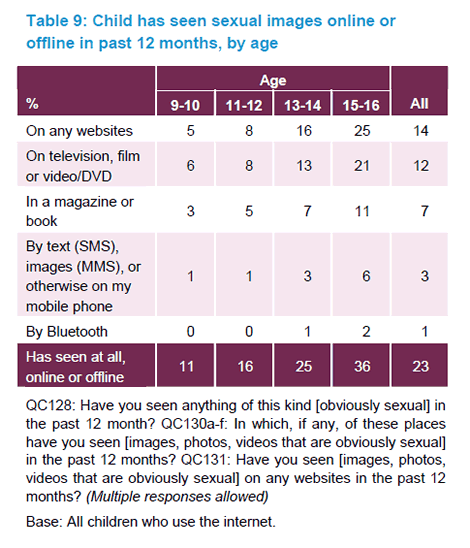 Okay, so we can’t make a direct comparison with the 2004 figures on totals because the EU Kids Online study does not include 17-19-year-olds and the age grouping are somewhat different but if you look at the figures for 9-10 and 11-12 age groups, the number of children reporting having sexual imagery either online or offline is just 11% at 9-10 and 16% at 11-12 compared to the 21% of British 9-11-year-olds who’d seen the same kind of imagery back in 2004, but in that case only online – and if we take offline imagery from television, DVDs and magazines and newspapers out of the picture then just 5% of 9-10 year olds and 8% of 11-12 year olds had seen any kind of sexual imagery online in the 2011 study.
Okay, so we can’t make a direct comparison with the 2004 figures on totals because the EU Kids Online study does not include 17-19-year-olds and the age grouping are somewhat different but if you look at the figures for 9-10 and 11-12 age groups, the number of children reporting having sexual imagery either online or offline is just 11% at 9-10 and 16% at 11-12 compared to the 21% of British 9-11-year-olds who’d seen the same kind of imagery back in 2004, but in that case only online – and if we take offline imagery from television, DVDs and magazines and newspapers out of the picture then just 5% of 9-10 year olds and 8% of 11-12 year olds had seen any kind of sexual imagery online in the 2011 study.
But hang on a second, isn’t there supposed to be a porn ‘epidemic’?
Maybe there is, but kids in 2010 don’t appear to been getting to see very much of it compared to their counterparts of just 6-7 years earlier, despite the rapid growth of social networking and the porn tube sector.
Okay, so let’s drill down a bit further and look at the figures for how child and young people are encountering sexual imagery online.
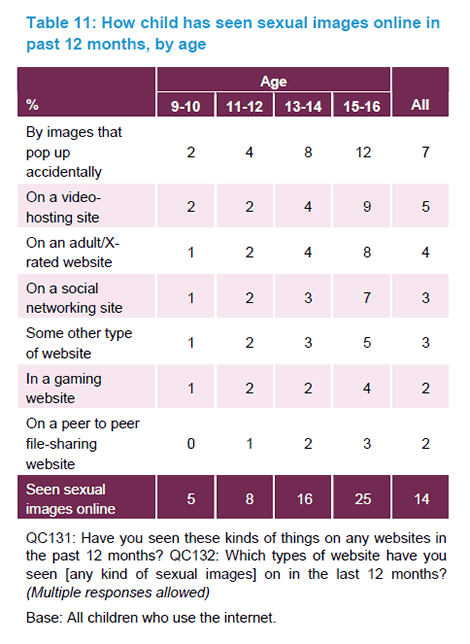
The first and most obvious thing to note is that pop-up have decline dramatically as a source of sexual imagery across all age groups, but particularly in the youngest age groups where just 2% of 9-10-year-olds and 4% of 11-12 year olds have run into pop-up porn advertising compared to the 38% on the 9-11 age group in the 2004 study.
Spam email also seems to fallen of the map and in its place we’re seeing more sexual imagery encountered through social networking, video hosting (i.e. Youtube, etc) and gaming websites but little or no change in the numbers of children and young people visiting actual porn sites and although websites, in general, top the list of overall sources of sexual imagery encountered by young people, when you take each type of site individually, none of them on their own tops either television and DVD’s or newspapers and magazines.
Now, I know that some people will look at those figures and think to themselves that is all well and good but it is European data, so what about just the UK. After all, we’re constantly being reminded by some politicians and media organisations that the UK has the highest teenage pregnancy rate in Western Europe and one of the highest abortion rates so where, exactly, do we fit into this overall picture?
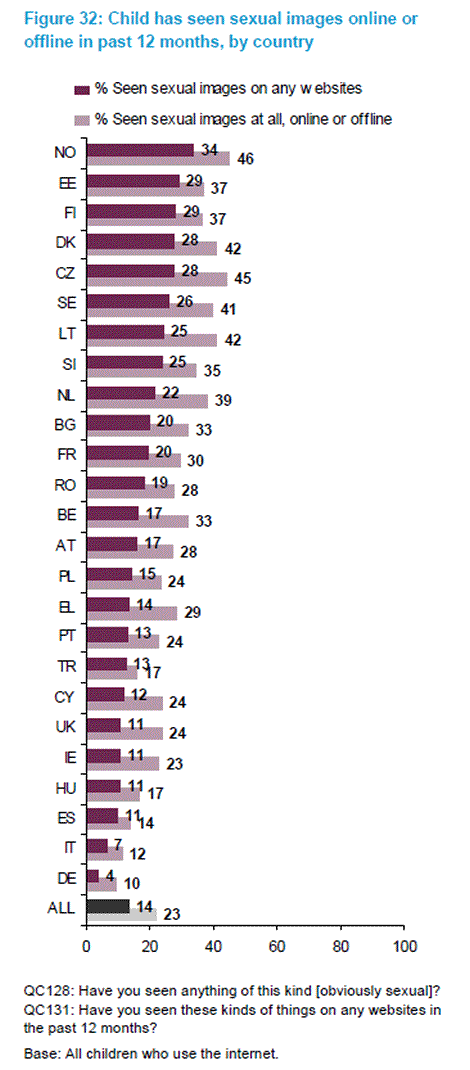
Yes, that is us just five places from the bottom of list with one of the lowest set for figures for children and young people having viewed sexual imagery online and from any online or offline sources. We’re actually about average in terms of sexual imagery via all media sources but somewhat below average in online access to porn and languishing well behind Scandinavia, Eastern Europe and most of Northern Europe with the exception of Germany.
In fact, as far as the overall picture goes, the report has this to say about young people and their access to sexual imagery:
On average, 14% of the children surveyed have seen sexual images online. It is noteworthy that exposure to such images on the internet is roughly associated with exposure across all media – in countries where more children have seen sexual images in general (especially, on television, film or video/DVD), it seems that children in those countries are also more likely to have encountered it online. In some countries, the internet represents a proportionately less important source of exposure to pornography (e.g. Germany, Ireland, Portugal, Greece and the UK). This suggests that if children do see sexual images in these countries it is often on other media. In other countries, it seems that the internet has become as or more common than any other source of pornography (e.g. Estonia, Finland, Turkey and Spain). National studies are needed to provide an explanation of these differences.
And what was the Daily Mail said, again?
Research has shown that 90 per cent of children aged eight to 16 have viewed porn online, often unintentionally.
So where exactly has the Mail been getting its figures?
Well, if we go right the way back to my first attempt to run down the source of the claim that the average age at which children first see porn is just eleven years of age you’ll see there a section that deals with a tech entrepreneur named Jerry Ropelato and an article published in Forbes Magazine in 2005 by Seth Lubove.
In that article, Lubove tracks the claim that the average age at which children start viewing porn in just eleven from a Democrat Senator speaking on the US Congressional Record to a Washington-based think-tank (‘Third Way’) which helps Democrats target ‘Red State’ (i.e. Republican issues) and from there back to… well, I’ll let Seth tell the rest of the story:
Where did Third Way get that notion? From a May 12 story in the New York Times-owned Boston Globe headlined “The Secret Life of Boys,” which cites an outfit called Family Safe Media. The small firm in Provo, Utah, is in the business of scaring parents into buying software to protect their kids from Internet smut. Jared Martin, who owns Family Safe Media, says he got his porn statistics from Internet Filter Review, a Web site that recommends content-blocking software. It is run by tech entrepreneur Jerry Ropelato of Huntsville, Utah, who pens antiporn screeds, such as “Tricks Pornographers Play,” and publishes curious and uncredited stats (for example, “17% of all women struggle with pornography addiction”).
“Most of the statistics there have come from literally hundreds of sources, all reputable,” Ropelato insists. He says he got the age-11 item from The Drug of the New Millennium, a book about the dangers of porn self-published in 2000 by Mark Kastleman, a self-professed former porn addict in Orem, Utah, who counsels other porn fiends. “I don’t remember where I got that from,” Kastleman says breezily. “That is a very common statistic.” And there the trail goes cold.
If you Google ‘Internet Pornography Statistics’ then you’ll find that the number one ranked search entry is Ropelato’s ‘Internet Filter Review’ site – and if you leave out the word Internet, Ropelato’s site currently ranks seventh behind Family Safe Media and two other sites that take their the figures from Ropelato’s site leaving only a Wikipedia page that doesn’t cite those figures.
So this is one of the current pages from Internet Filter Review – see if you spot anything that seems familiar…
Yes, there the claim about 11-year-olds that Seth Lubove tracked back to Ropelato and from there to Kastleman, who can’t remember where he got the figure from and who has since dropped it from the second edition of his book.
And yes, we also have the ‘90% of 8-16 year olds’ claim, which I’ve now pretty much debunked and doesn’t that claim about 80% of 15-17 year olds having ‘multiple hardcore exposures’ look rather lot like the Mail’s claim that ‘around 80% of teenagers regularly access porn’?
What we’re looking at here is what could quite reasonably be termed ‘statistics laundering’ – see here and here.
What Ropelato is doing, and has been doing for a considerable number of years, is packaging together a large and readily accessible compendium of ‘statistics’ relating to online pornography some of which do come from genuine sources (e.g. general statistics from business intelligence companies, web search metrics from SEO businesses and odd bits of published research) into which he also bundles exaggerated and alarmist figures from much more dubious sources, e.g. conservative/religious anti-porn campaigners, and – as we’ve already seen, figures what appear to have simply made up out of thin air.
These figures are then published without any individual attributions or links back to sources and fed to other websites, particularly those run by anti-campaigners and conservative religious organisations, and also to newspaper and other media organisations.
Although he doesn’t individually attribute most of his figures, what Ropelato does provide on his site is the following generic list of sources:
Sources:
Statistics are compiled from the credible sources mentioned below. In reality, statistics are hard to ascertain and may be estimated by local and regional worldwide sources.
ABC, Associated Press, AsiaMedia, AVN, BBC, CATW, U.S. Census, Central Intelligence Agency, China Daily, Chosen.com, Comscore Media Metrix, Crimes Against Children, Eros, Forbes, Frankfurt Stock Exchange, Free Speech Coalition, Google, Harris Interactive, Hitwise, Hoover’s, Japan Inc., Japan Review, Juniper Research, Kagan Research, ICMEC, Jan LaRue, The Miami Herald, MSN, Nielsen/NetRatings, The New York Times, Nordic Institute, PhysOrg.com, PornStudies, Pravda, Sarmatian Review, SEC filings, Secure Computing Corp., SMH, TopTenREVIEWS, Trellian, WICAT, Yahoo!, XBIZ
Now a couple of things jump out from that list straight away.
One is that there’s quite a number of media companies in there, companies that may quite easily have taken and published figures from Ropelato’s site, creating a self-citation circle-jerk which may quite easily conceal the fact that some of the companies that Ropelato is citing as his sources may quite easily have been sourcing their information from his site.
And the list also includes ‘Top Ten Reviews’, which is Ropelato’s own website, so we have a clear case of self-citation on our hands, but curiously it doesn’t cite Kastleman’s book as a source for the claim about 11 year olds and nor does it mention that the sources I’ve traced for some his other figures include the Family Research Council and Focus on the Family, although back in 2004 his site did include a link to Focus on the Family in its resources section, which has since been quietly removed.
I’m also rather curious about a couple of Ropelato’s listed sources.
For starter’s there’s the ‘Nordic Institute’ for which one can only ask ‘which one?’.
There’s a Nordic Institute of Theoretical Physics, a Nordic Institute of Dental Materials and a Nordic Institute of Stage and Studio. There’s a Nordic Institute in Finland and a Nordic Institute in Greenland, not to mention a Nordic Gender Institute that used to be the Nordic Institute for Women’s Studies and Gender Research, but that closed in 2011, and there’s a Nordic Sami Institute, a Nordic Africa Institute and a Nordic Institute for Missological and Ecumenical Research.
But what I’ve been able to find anywhere, as yet, is a plain old ‘Nordic Institute’.
Then there’s ‘Porn Studies‘, which does at least appear to be a genuine academic journal but with a slight wrinkle in so far as it’s first quarterly issue will not be published until Spring 2014.
One statistic that has disappeared from Ropelato’s dodgy compendium in recent years is the claim that the largest consumers of Internet pornography are the 12-17 age group, which features in this press release from 2004 but has since been replaced by a much more plausible claim that it is, in fact, the 35-49 age group.
It’s a measure of just how shoddy Ropelato’s ‘research’ practices are that that particular claim about 12-17 year olds is easily traced back to its original source, the Meese Report, which was published in July 1986, five years before the first ever webpage was published by Tim Berners-Lee at CERN.
The dismal fact here is that if you look for statistics relating or pornography on the Internet then pretty much all roads lead, one way or another, back to Ropelato and his ‘Internet Filter Review’ website, which has been spewing out false information and generally poisoning the whole debate surrounding children and online safety since at least 2004 – the earliest date for which a snapshot of the site has been captured by Wayback Machine. That figures from that site turned up in Daily Mail article in 2013 is both a matter for concern and further evidence to show that significant parts of the press are routinely failing to do any kind of fact-checking at all before going to print.
ADDENDUM -23 May 2013
Purely as a matter of curiosity, I’ve used Amazon’s ‘look inside’ facility to quickly check a couple of the more prominent feminist books that promote the concept of ‘pornification’, specifically Gail Dines’ “Pornland: How Porn Has Hijacked Our Sexuality” and “Big Porn Inc: Exposing the Harms of the Global Porn Industry” by Melinda Tankard Reist and Abigail Bray.
In both books you will find Ropelato’s ‘Internet Filter Review’ cited as source of ‘statistics’ used by the authors.
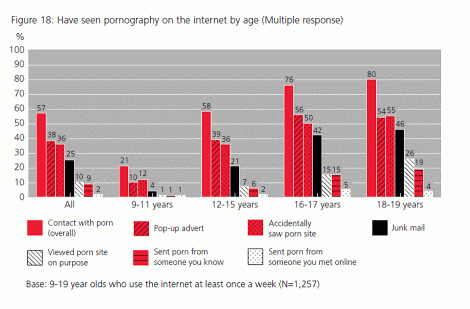
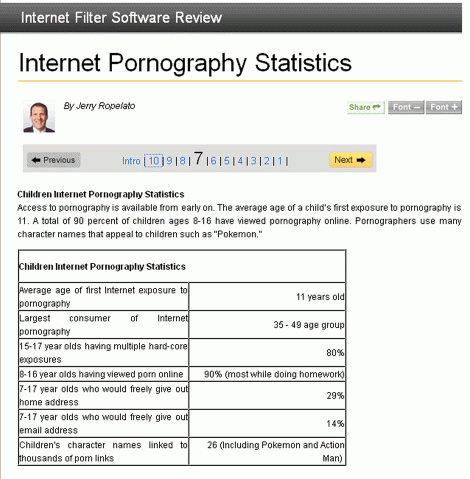
I’m not sure how these figures on ‘sexual imagery’ were compiled.
Do different age groups, religious groupings etc have different perspectives?
For example Is a nude woman sexual imagery?